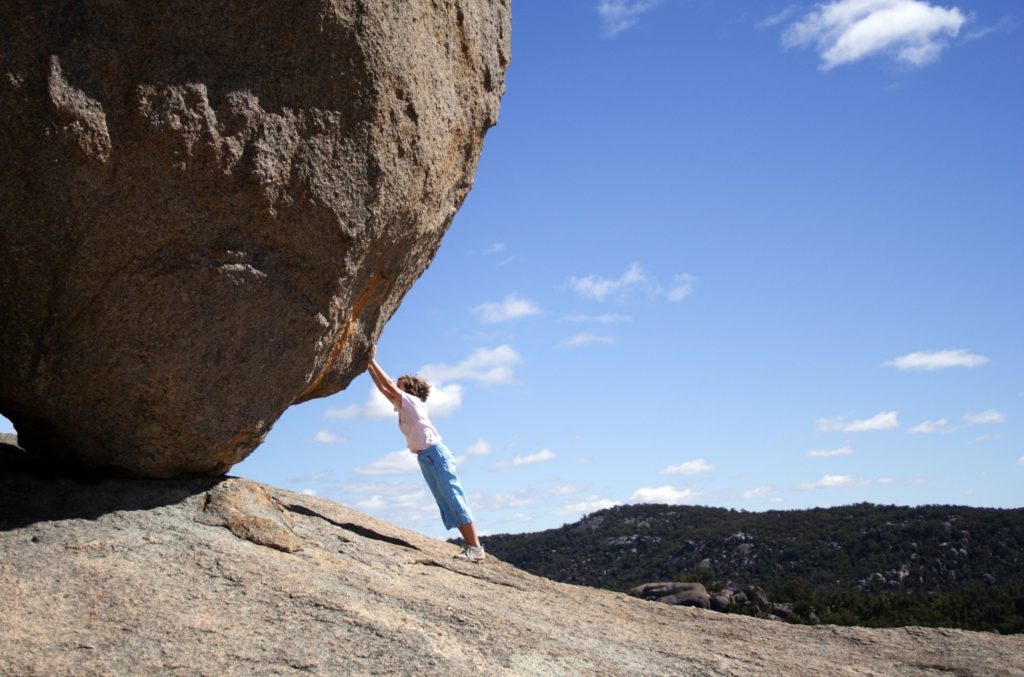Despite the brilliance of the human mind, some of our thought patterns can cause emotional pain. One such pattern is called “catastrophizing,” a term coined by psychologist Albert Ellis to describe “the tendency to magnify a perceived threat and overestimate the seriousness of its potential consequences.”
Put more simply, catastrophic thinking is the tendency to imagine the worst-case scenario.
Despite the brilliance of the human mind, some of our thought patterns can cause emotional pain. One such pattern is called “catastrophizing,” a term coined by psychologist Albert Ellis to describe “the tendency to magnify a perceived threat and overestimate the seriousness of its potential consequences.”
Put more simply, catastrophic thinking is the tendency to imagine the worst-case scenario.
How to recognize catastrophizing
One challenge with recognizing symptoms of anxiety, like catastrophic thinking, is that it feels so real, we may not even think to question it. We’re wearing magnifying glasses that turn molehills into mountains, but we don’t know we’re wearing them.
The first step to recognizing catastrophic thinking is to know where to look. Author and psychologist Daniel Goleman writes, “Worries are almost always expressed in the mind’s ear, not its eye—that is, in words, not images—a fact that has significance for controlling worry.”
By observing the content of our thoughts, we may be surprised to notice how often we take mental leaps away from reality. For instance, perhaps a mistake at work ignites the thought,
“I’m going to get fired.” This can turn mild worry into extreme anxiety.
Maybe muscle pain ignites the thought, “I’m seriously ill.” Or perhaps a bad morning has us thinking, “this day is the worst,” even though it’s only just begun. These are all examples of catastrophizing.
Discover how mindful breathing can help your anxiety.
What happens when we catastrophize
When left unchecked, catastrophizing thoughts can lead us spiraling down the rabbit hole of negative emotions and behaviors that don’t align with our highest goals.
The cognitive triangle, a visual illustration from Cognitive Behavioral Therapy (CBT), shows the relationship between what we think, what we feel, and what we do.
Let’s imagine I arrive 5 minutes late to a job interview. Frustrated with my lateness, I think, “I probably won’t get the job.” From there, I start to suspect that I’m totally incompetent. And just a moment later, I find myself believing that no one will ever hire me again.
My catastrophic thinking turned my being a few minutes late into a lifetime of chronic unemployment.
Of course, this train of thought, which feels so real, isn’t setting me up for a successful interview. I feel fearful and angry with myself, which, in turn, shifts how I act in the interview. Instead of showing up with confidence, I am overly apologetic and distracted.
Although we may not even recognize that we’re catastrophizing, the thoughts themselves can dramatically affect how we feel and how we act. That’s why awareness of triggering situations and events can help us work with this pattern in a way that calms anxiety and worry.
Learn how rumination can impact your wellbeing— and how to work with it.
How to work with catastrophic thinking
The good news is that there are multiple tools that you can use to work with catastrophic thinking effectively. Here are 6 of my favorites.
1. Notice it.
The first step to change is almost always awareness. The next time something doesn’t go as planned, try observing the content of your thoughts. Grab a notebook or voice recorder and express what your mind is telling you.
If you’re anything like the rest of us, you may be surprised at just how unhelpful some of your thought patterns are. That’s okay; the human mind has a negativity bias woven into its default network.
When we notice these patterns for what they are, a bias rather than the truth, we often find we have the capacity to hear the thoughts without being ruled by them.
2. Name it.
Psychiatrist and author Dan Siegel suggests that you “name it to tame it.” Although catastrophizing can be extremely uncomfortable, I’ve often felt grateful that it has a name.
When we can put our difficult experiences into words, not only do we feel a little better, but we actually change the brain in detectable ways.
For instance, fMRI studies show that a practice called affect labeling can reduce activity in the amygdala, the part of our brain associated with fear. When you notice yourself imagining the worst possible outcome, try simply noting to yourself, without judgment, “catastrophizing.” Give it any label that makes sense to you.
3. Counterbalance.
When imagining the worst-case scenario, try asking yourself the following three questions. The point isn’t to rip off our worst-case-scenario binoculars. Instead, we’ll bring in additional lenses that encourage flexibility.
- What is the worst-case scenario? (You are likely already thinking about this.)
- And what is the best-case scenario? (This may feel like a stretch, but try anyway!)
- Finally, what is the most likely scenario? (The mental contrasting of best vs. worst can give your mind the perspective it needs to consider possibility and probability)
4. Dialogue with your mind.
In over 15 years of working with humans towards positive behavior change, I’ve never seen someone change because I told them to. It’s often the same when we work with our own minds.
The mind doesn’t change because we tell it, “you need to change.” But we can encourage a shift in our thinking through dialogue. We can work with our catastrophic thinking by engaging with it in dialogue. Try asking questions like these:
- Am I sure this is a disaster?
- Do I actually have evidence to support that?
- Is there another possibility?
- How might someone who cares about me and sees the best in me view the situation?
- What impact does my seeing the worst-case scenario have on me? What are the benefits and harms?
5. Shift beliefs to shift reality.
Taking on alternative perspectives can shift how you think, feel, and act. Check out the table below, where we’ll use the “late to job interview” situation from earlier.
Here’s how a cognitive behavioral therapist might work with someone to shift negative thought patterns.
The first row illustrates how the catastrophic thought sequence impacts feelings and behaviors. But when we replace catastrophizing with alternative thoughts and beliefs, as in the second row, we can shift the feelings and behaviors that follow.
Notice that the details of the event haven’t changed. But by changing how we interpret the event, we can radically alter our reality.
| Pathway 1 Catastrophic thinking | Pathway 2 Grounding alternative |
| Event I was 5 minutes late for my job interview. | Event 5 minutes late for a job interview |
| Thoughts I won’t get the job. I’ll be unemployed forever. I will lose my home. | Thoughts This isn’t ideal. Maybe it’s an opportunity. I can demonstrate how I handle mistakes. |
| Feelings Worry Anxiety Anger at self | Feelings Engaged Present Focused |
| Behaviors Overly apologetic Focused on my mistake Can’t connect with the interviewer | Behaviors Take a deep breath Intentionally reset Actively connecting with interviewer |
6. Calm your system.
You can calm your body and mind with breathing exercises. When you experience stress, anxiety, or panic, your body’s fight-or-flight response is triggered, causing physiological changes in your body.
These changes are often the same as the symptoms of anxiety, like elevated heart rate and blood pressure, muscle tension, sweating, and shallow breathing.
But breathing exercises for anxiety can directly counteract these symptoms, calming and soothing your entire system.
Box breathing, also sometimes square breathing, is a Navy Seal technique you can use to manage the physical experience of anxiety or panic. Deep breathing exercises like this one activate your body’s built-in relaxation system, the parasympathetic nervous system.
Here’s how to do it:
- Start with a deep breath in and a long, slow exhale
- Breathe in for a count of 4
- Hold your breath for a count of 4
- Breathe out for a count of 4
- Hold your breath for a count of 4
You can practice this breath technique anytime, anywhere when you notice that catastrophic thinking is causing stress levels to rise. Repeat this cycle for as many rounds as would feel good, and use it as often as you like.
Discover how to stop a panic attack right now.
Takeaway
- Catastrophizing is the tendency to imagine the worst possible outcome.
- Although catastrophizing is a common human thought pattern, left unchecked, it can lead to consequences such as negative mood, anxiety, or avoidance.
- There are proven tools to help manage catastrophizing, including awareness, mindfulness, shifting your thoughts, and breathing exercises.











